Breaking Through the Barriers to Well-being
VerifiedAdded on 2019/09/24
|6
|1798
|286
Essay
AI Summary
This assignment content discusses the importance of providing appropriate social services and ensuring that disabled people's needs are fully taken into account. It also highlights the significance of person-centred care, particularly in dementia care, which recognizes the individual's unique values and personality. The dialectical model of dementia emphasizes the inter-relationship between neurological and social-psychological factors, while the biopsychosocial model identifies factors that may lead to either improvement or deterioration in the person. The assignment also explores psychosocial interventions, including support at diagnosis, cognition enhancement, and psychological adjustment, with the goal of reducing future disabilities.
Contribute Materials
Your contribution can guide someone’s learning journey. Share your
documents today.
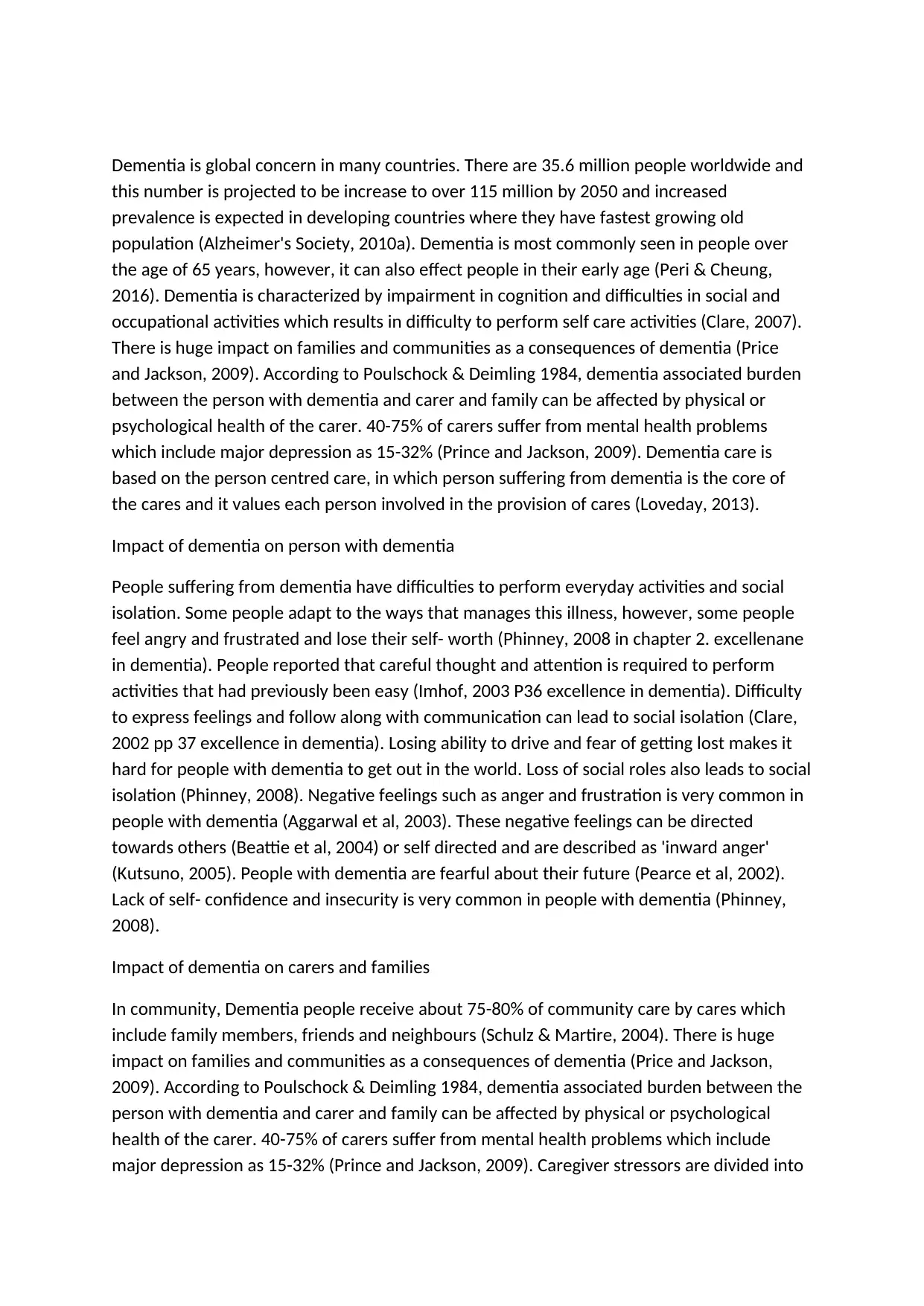
Dementia is global concern in many countries. There are 35.6 million people worldwide and
this number is projected to be increase to over 115 million by 2050 and increased
prevalence is expected in developing countries where they have fastest growing old
population (Alzheimer's Society, 2010a). Dementia is most commonly seen in people over
the age of 65 years, however, it can also effect people in their early age (Peri & Cheung,
2016). Dementia is characterized by impairment in cognition and difficulties in social and
occupational activities which results in difficulty to perform self care activities (Clare, 2007).
There is huge impact on families and communities as a consequences of dementia (Price
and Jackson, 2009). According to Poulschock & Deimling 1984, dementia associated burden
between the person with dementia and carer and family can be affected by physical or
psychological health of the carer. 40-75% of carers suffer from mental health problems
which include major depression as 15-32% (Prince and Jackson, 2009). Dementia care is
based on the person centred care, in which person suffering from dementia is the core of
the cares and it values each person involved in the provision of cares (Loveday, 2013).
Impact of dementia on person with dementia
People suffering from dementia have difficulties to perform everyday activities and social
isolation. Some people adapt to the ways that manages this illness, however, some people
feel angry and frustrated and lose their self- worth (Phinney, 2008 in chapter 2. excellenane
in dementia). People reported that careful thought and attention is required to perform
activities that had previously been easy (Imhof, 2003 P36 excellence in dementia). Difficulty
to express feelings and follow along with communication can lead to social isolation (Clare,
2002 pp 37 excellence in dementia). Losing ability to drive and fear of getting lost makes it
hard for people with dementia to get out in the world. Loss of social roles also leads to social
isolation (Phinney, 2008). Negative feelings such as anger and frustration is very common in
people with dementia (Aggarwal et al, 2003). These negative feelings can be directed
towards others (Beattie et al, 2004) or self directed and are described as 'inward anger'
(Kutsuno, 2005). People with dementia are fearful about their future (Pearce et al, 2002).
Lack of self- confidence and insecurity is very common in people with dementia (Phinney,
2008).
Impact of dementia on carers and families
In community, Dementia people receive about 75-80% of community care by cares which
include family members, friends and neighbours (Schulz & Martire, 2004). There is huge
impact on families and communities as a consequences of dementia (Price and Jackson,
2009). According to Poulschock & Deimling 1984, dementia associated burden between the
person with dementia and carer and family can be affected by physical or psychological
health of the carer. 40-75% of carers suffer from mental health problems which include
major depression as 15-32% (Prince and Jackson, 2009). Caregiver stressors are divided into
this number is projected to be increase to over 115 million by 2050 and increased
prevalence is expected in developing countries where they have fastest growing old
population (Alzheimer's Society, 2010a). Dementia is most commonly seen in people over
the age of 65 years, however, it can also effect people in their early age (Peri & Cheung,
2016). Dementia is characterized by impairment in cognition and difficulties in social and
occupational activities which results in difficulty to perform self care activities (Clare, 2007).
There is huge impact on families and communities as a consequences of dementia (Price
and Jackson, 2009). According to Poulschock & Deimling 1984, dementia associated burden
between the person with dementia and carer and family can be affected by physical or
psychological health of the carer. 40-75% of carers suffer from mental health problems
which include major depression as 15-32% (Prince and Jackson, 2009). Dementia care is
based on the person centred care, in which person suffering from dementia is the core of
the cares and it values each person involved in the provision of cares (Loveday, 2013).
Impact of dementia on person with dementia
People suffering from dementia have difficulties to perform everyday activities and social
isolation. Some people adapt to the ways that manages this illness, however, some people
feel angry and frustrated and lose their self- worth (Phinney, 2008 in chapter 2. excellenane
in dementia). People reported that careful thought and attention is required to perform
activities that had previously been easy (Imhof, 2003 P36 excellence in dementia). Difficulty
to express feelings and follow along with communication can lead to social isolation (Clare,
2002 pp 37 excellence in dementia). Losing ability to drive and fear of getting lost makes it
hard for people with dementia to get out in the world. Loss of social roles also leads to social
isolation (Phinney, 2008). Negative feelings such as anger and frustration is very common in
people with dementia (Aggarwal et al, 2003). These negative feelings can be directed
towards others (Beattie et al, 2004) or self directed and are described as 'inward anger'
(Kutsuno, 2005). People with dementia are fearful about their future (Pearce et al, 2002).
Lack of self- confidence and insecurity is very common in people with dementia (Phinney,
2008).
Impact of dementia on carers and families
In community, Dementia people receive about 75-80% of community care by cares which
include family members, friends and neighbours (Schulz & Martire, 2004). There is huge
impact on families and communities as a consequences of dementia (Price and Jackson,
2009). According to Poulschock & Deimling 1984, dementia associated burden between the
person with dementia and carer and family can be affected by physical or psychological
health of the carer. 40-75% of carers suffer from mental health problems which include
major depression as 15-32% (Prince and Jackson, 2009). Caregiver stressors are divided into
Secure Best Marks with AI Grader
Need help grading? Try our AI Grader for instant feedback on your assignments.
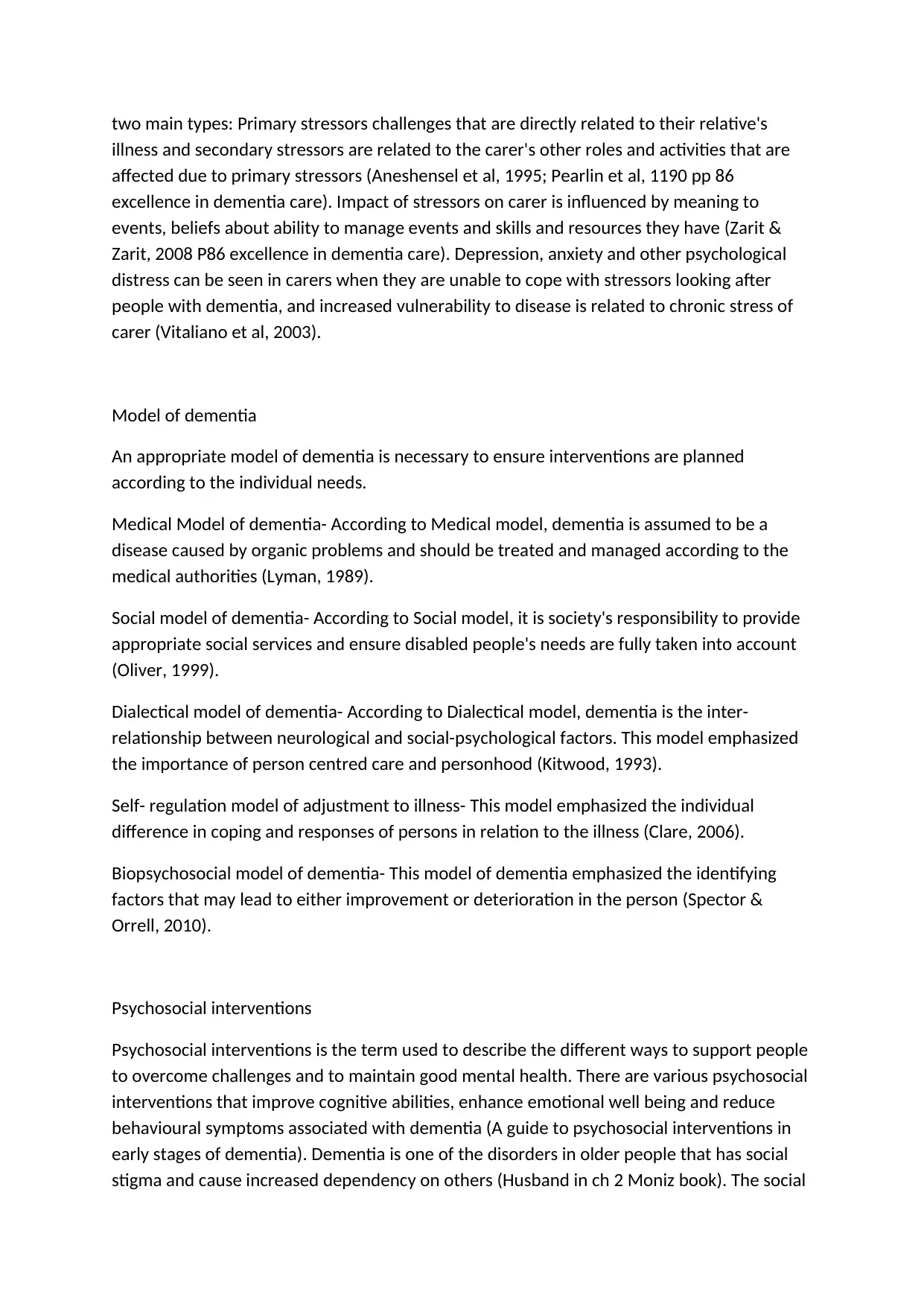
two main types: Primary stressors challenges that are directly related to their relative's
illness and secondary stressors are related to the carer's other roles and activities that are
affected due to primary stressors (Aneshensel et al, 1995; Pearlin et al, 1190 pp 86
excellence in dementia care). Impact of stressors on carer is influenced by meaning to
events, beliefs about ability to manage events and skills and resources they have (Zarit &
Zarit, 2008 P86 excellence in dementia care). Depression, anxiety and other psychological
distress can be seen in carers when they are unable to cope with stressors looking after
people with dementia, and increased vulnerability to disease is related to chronic stress of
carer (Vitaliano et al, 2003).
Model of dementia
An appropriate model of dementia is necessary to ensure interventions are planned
according to the individual needs.
Medical Model of dementia- According to Medical model, dementia is assumed to be a
disease caused by organic problems and should be treated and managed according to the
medical authorities (Lyman, 1989).
Social model of dementia- According to Social model, it is society's responsibility to provide
appropriate social services and ensure disabled people's needs are fully taken into account
(Oliver, 1999).
Dialectical model of dementia- According to Dialectical model, dementia is the inter-
relationship between neurological and social-psychological factors. This model emphasized
the importance of person centred care and personhood (Kitwood, 1993).
Self- regulation model of adjustment to illness- This model emphasized the individual
difference in coping and responses of persons in relation to the illness (Clare, 2006).
Biopsychosocial model of dementia- This model of dementia emphasized the identifying
factors that may lead to either improvement or deterioration in the person (Spector &
Orrell, 2010).
Psychosocial interventions
Psychosocial interventions is the term used to describe the different ways to support people
to overcome challenges and to maintain good mental health. There are various psychosocial
interventions that improve cognitive abilities, enhance emotional well being and reduce
behavioural symptoms associated with dementia (A guide to psychosocial interventions in
early stages of dementia). Dementia is one of the disorders in older people that has social
stigma and cause increased dependency on others (Husband in ch 2 Moniz book). The social
illness and secondary stressors are related to the carer's other roles and activities that are
affected due to primary stressors (Aneshensel et al, 1995; Pearlin et al, 1190 pp 86
excellence in dementia care). Impact of stressors on carer is influenced by meaning to
events, beliefs about ability to manage events and skills and resources they have (Zarit &
Zarit, 2008 P86 excellence in dementia care). Depression, anxiety and other psychological
distress can be seen in carers when they are unable to cope with stressors looking after
people with dementia, and increased vulnerability to disease is related to chronic stress of
carer (Vitaliano et al, 2003).
Model of dementia
An appropriate model of dementia is necessary to ensure interventions are planned
according to the individual needs.
Medical Model of dementia- According to Medical model, dementia is assumed to be a
disease caused by organic problems and should be treated and managed according to the
medical authorities (Lyman, 1989).
Social model of dementia- According to Social model, it is society's responsibility to provide
appropriate social services and ensure disabled people's needs are fully taken into account
(Oliver, 1999).
Dialectical model of dementia- According to Dialectical model, dementia is the inter-
relationship between neurological and social-psychological factors. This model emphasized
the importance of person centred care and personhood (Kitwood, 1993).
Self- regulation model of adjustment to illness- This model emphasized the individual
difference in coping and responses of persons in relation to the illness (Clare, 2006).
Biopsychosocial model of dementia- This model of dementia emphasized the identifying
factors that may lead to either improvement or deterioration in the person (Spector &
Orrell, 2010).
Psychosocial interventions
Psychosocial interventions is the term used to describe the different ways to support people
to overcome challenges and to maintain good mental health. There are various psychosocial
interventions that improve cognitive abilities, enhance emotional well being and reduce
behavioural symptoms associated with dementia (A guide to psychosocial interventions in
early stages of dementia). Dementia is one of the disorders in older people that has social
stigma and cause increased dependency on others (Husband in ch 2 Moniz book). The social
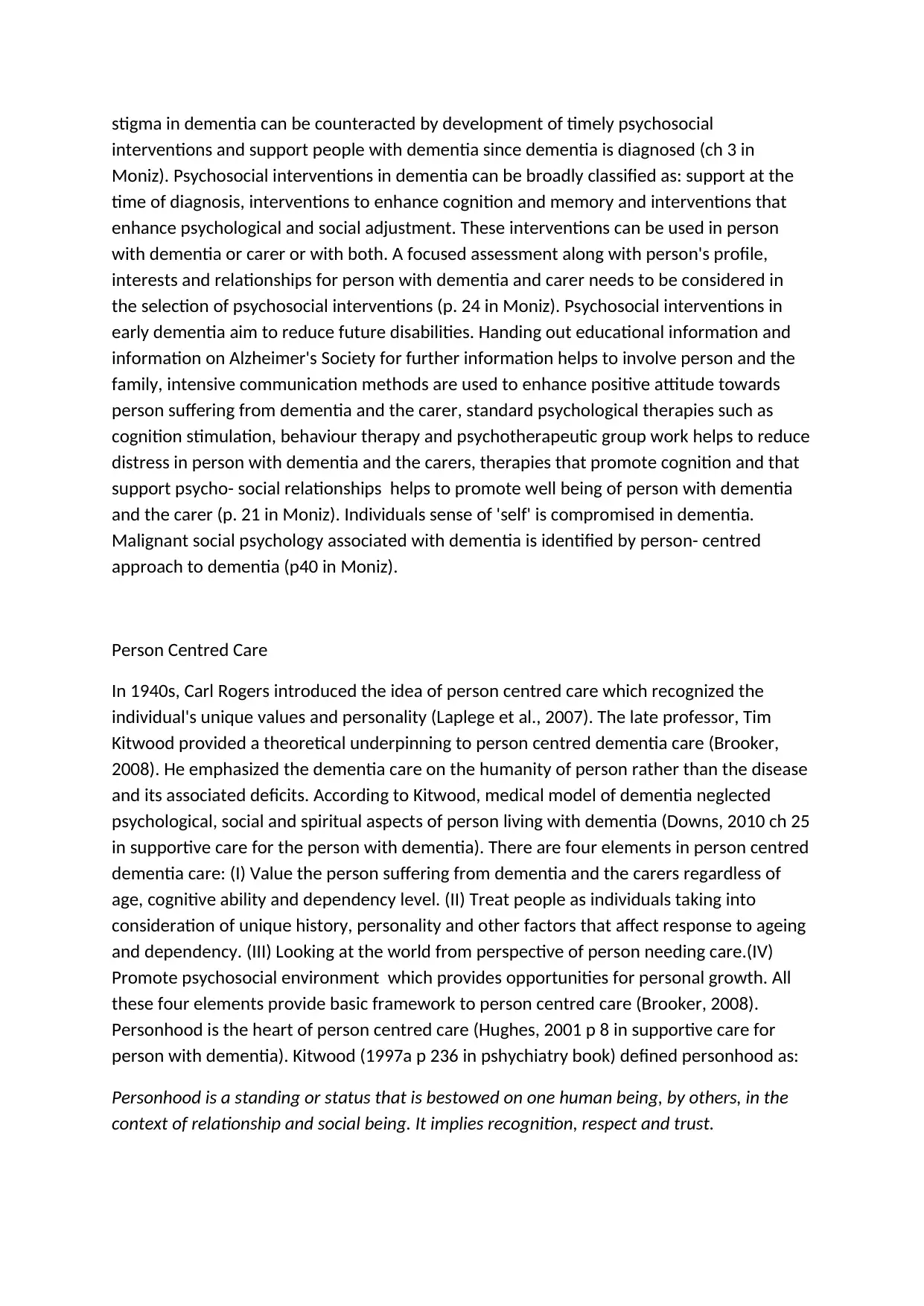
stigma in dementia can be counteracted by development of timely psychosocial
interventions and support people with dementia since dementia is diagnosed (ch 3 in
Moniz). Psychosocial interventions in dementia can be broadly classified as: support at the
time of diagnosis, interventions to enhance cognition and memory and interventions that
enhance psychological and social adjustment. These interventions can be used in person
with dementia or carer or with both. A focused assessment along with person's profile,
interests and relationships for person with dementia and carer needs to be considered in
the selection of psychosocial interventions (p. 24 in Moniz). Psychosocial interventions in
early dementia aim to reduce future disabilities. Handing out educational information and
information on Alzheimer's Society for further information helps to involve person and the
family, intensive communication methods are used to enhance positive attitude towards
person suffering from dementia and the carer, standard psychological therapies such as
cognition stimulation, behaviour therapy and psychotherapeutic group work helps to reduce
distress in person with dementia and the carers, therapies that promote cognition and that
support psycho- social relationships helps to promote well being of person with dementia
and the carer (p. 21 in Moniz). Individuals sense of 'self' is compromised in dementia.
Malignant social psychology associated with dementia is identified by person- centred
approach to dementia (p40 in Moniz).
Person Centred Care
In 1940s, Carl Rogers introduced the idea of person centred care which recognized the
individual's unique values and personality (Laplege et al., 2007). The late professor, Tim
Kitwood provided a theoretical underpinning to person centred dementia care (Brooker,
2008). He emphasized the dementia care on the humanity of person rather than the disease
and its associated deficits. According to Kitwood, medical model of dementia neglected
psychological, social and spiritual aspects of person living with dementia (Downs, 2010 ch 25
in supportive care for the person with dementia). There are four elements in person centred
dementia care: (I) Value the person suffering from dementia and the carers regardless of
age, cognitive ability and dependency level. (II) Treat people as individuals taking into
consideration of unique history, personality and other factors that affect response to ageing
and dependency. (III) Looking at the world from perspective of person needing care.(IV)
Promote psychosocial environment which provides opportunities for personal growth. All
these four elements provide basic framework to person centred care (Brooker, 2008).
Personhood is the heart of person centred care (Hughes, 2001 p 8 in supportive care for
person with dementia). Kitwood (1997a p 236 in pshychiatry book) defined personhood as:
Personhood is a standing or status that is bestowed on one human being, by others, in the
context of relationship and social being. It implies recognition, respect and trust.
interventions and support people with dementia since dementia is diagnosed (ch 3 in
Moniz). Psychosocial interventions in dementia can be broadly classified as: support at the
time of diagnosis, interventions to enhance cognition and memory and interventions that
enhance psychological and social adjustment. These interventions can be used in person
with dementia or carer or with both. A focused assessment along with person's profile,
interests and relationships for person with dementia and carer needs to be considered in
the selection of psychosocial interventions (p. 24 in Moniz). Psychosocial interventions in
early dementia aim to reduce future disabilities. Handing out educational information and
information on Alzheimer's Society for further information helps to involve person and the
family, intensive communication methods are used to enhance positive attitude towards
person suffering from dementia and the carer, standard psychological therapies such as
cognition stimulation, behaviour therapy and psychotherapeutic group work helps to reduce
distress in person with dementia and the carers, therapies that promote cognition and that
support psycho- social relationships helps to promote well being of person with dementia
and the carer (p. 21 in Moniz). Individuals sense of 'self' is compromised in dementia.
Malignant social psychology associated with dementia is identified by person- centred
approach to dementia (p40 in Moniz).
Person Centred Care
In 1940s, Carl Rogers introduced the idea of person centred care which recognized the
individual's unique values and personality (Laplege et al., 2007). The late professor, Tim
Kitwood provided a theoretical underpinning to person centred dementia care (Brooker,
2008). He emphasized the dementia care on the humanity of person rather than the disease
and its associated deficits. According to Kitwood, medical model of dementia neglected
psychological, social and spiritual aspects of person living with dementia (Downs, 2010 ch 25
in supportive care for the person with dementia). There are four elements in person centred
dementia care: (I) Value the person suffering from dementia and the carers regardless of
age, cognitive ability and dependency level. (II) Treat people as individuals taking into
consideration of unique history, personality and other factors that affect response to ageing
and dependency. (III) Looking at the world from perspective of person needing care.(IV)
Promote psychosocial environment which provides opportunities for personal growth. All
these four elements provide basic framework to person centred care (Brooker, 2008).
Personhood is the heart of person centred care (Hughes, 2001 p 8 in supportive care for
person with dementia). Kitwood (1997a p 236 in pshychiatry book) defined personhood as:
Personhood is a standing or status that is bestowed on one human being, by others, in the
context of relationship and social being. It implies recognition, respect and trust.
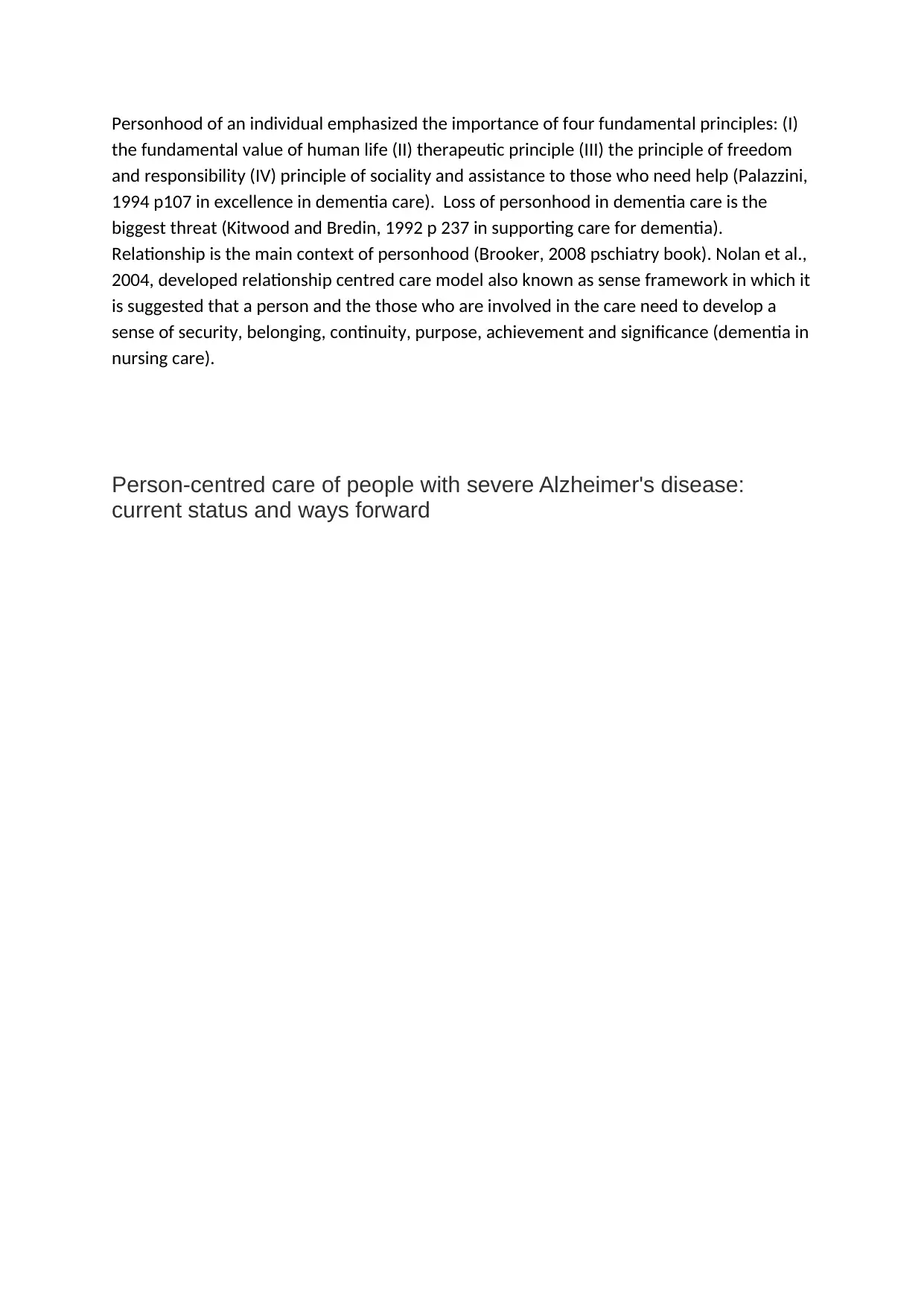
Personhood of an individual emphasized the importance of four fundamental principles: (I)
the fundamental value of human life (II) therapeutic principle (III) the principle of freedom
and responsibility (IV) principle of sociality and assistance to those who need help (Palazzini,
1994 p107 in excellence in dementia care). Loss of personhood in dementia care is the
biggest threat (Kitwood and Bredin, 1992 p 237 in supporting care for dementia).
Relationship is the main context of personhood (Brooker, 2008 pschiatry book). Nolan et al.,
2004, developed relationship centred care model also known as sense framework in which it
is suggested that a person and the those who are involved in the care need to develop a
sense of security, belonging, continuity, purpose, achievement and significance (dementia in
nursing care).
Person-centred care of people with severe Alzheimer's disease:
current status and ways forward
the fundamental value of human life (II) therapeutic principle (III) the principle of freedom
and responsibility (IV) principle of sociality and assistance to those who need help (Palazzini,
1994 p107 in excellence in dementia care). Loss of personhood in dementia care is the
biggest threat (Kitwood and Bredin, 1992 p 237 in supporting care for dementia).
Relationship is the main context of personhood (Brooker, 2008 pschiatry book). Nolan et al.,
2004, developed relationship centred care model also known as sense framework in which it
is suggested that a person and the those who are involved in the care need to develop a
sense of security, belonging, continuity, purpose, achievement and significance (dementia in
nursing care).
Person-centred care of people with severe Alzheimer's disease:
current status and ways forward
Secure Best Marks with AI Grader
Need help grading? Try our AI Grader for instant feedback on your assignments.
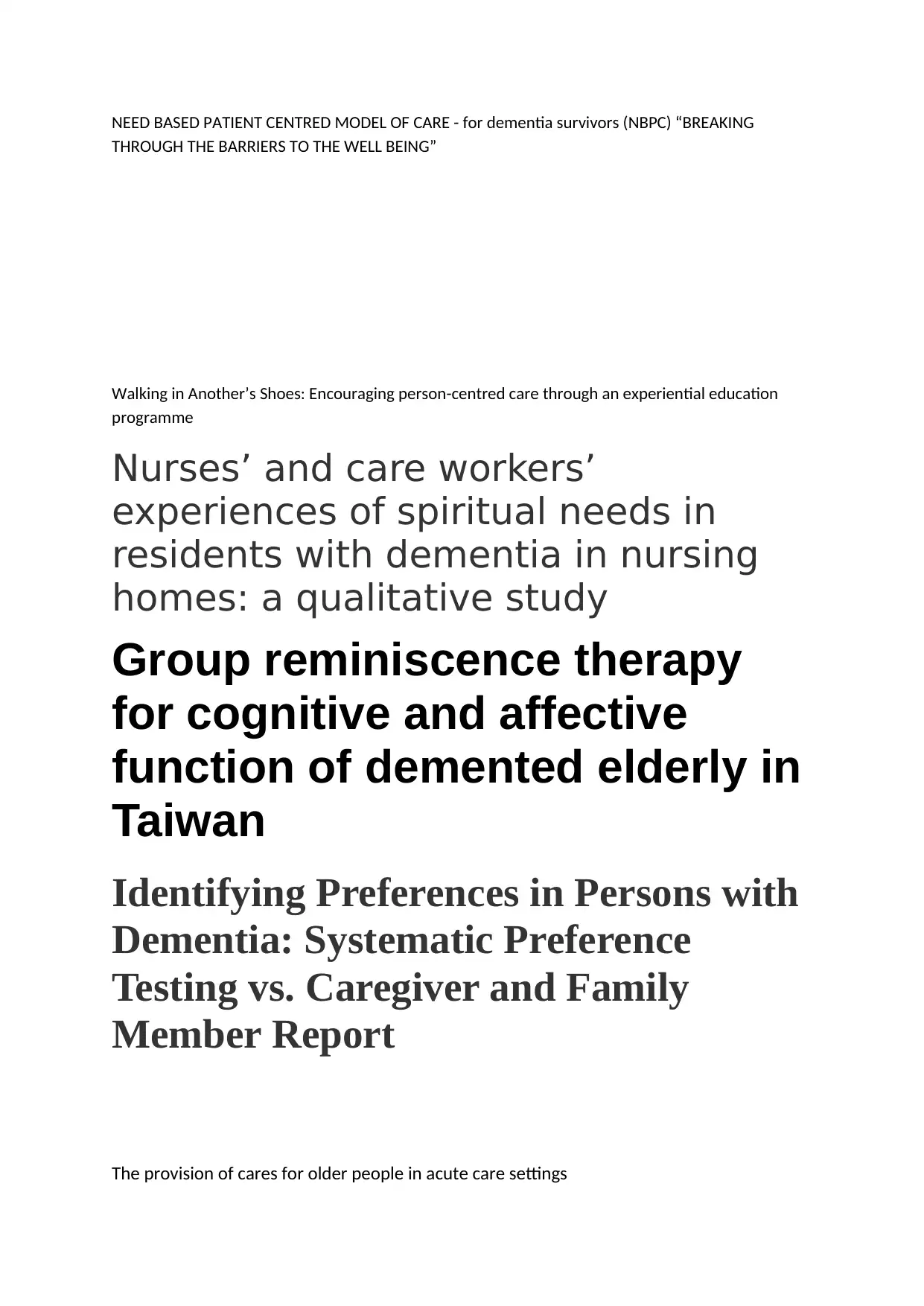
NEED BASED PATIENT CENTRED MODEL OF CARE - for dementia survivors (NBPC) “BREAKING
THROUGH THE BARRIERS TO THE WELL BEING”
Walking in Another’s Shoes: Encouraging person-centred care through an experiential education
programme
Nurses’ and care workers’
experiences of spiritual needs in
residents with dementia in nursing
homes: a qualitative study
Group reminiscence therapy
for cognitive and affective
function of demented elderly in
Taiwan
Identifying Preferences in Persons with
Dementia: Systematic Preference
Testing vs. Caregiver and Family
Member Report
The provision of cares for older people in acute care settings
THROUGH THE BARRIERS TO THE WELL BEING”
Walking in Another’s Shoes: Encouraging person-centred care through an experiential education
programme
Nurses’ and care workers’
experiences of spiritual needs in
residents with dementia in nursing
homes: a qualitative study
Group reminiscence therapy
for cognitive and affective
function of demented elderly in
Taiwan
Identifying Preferences in Persons with
Dementia: Systematic Preference
Testing vs. Caregiver and Family
Member Report
The provision of cares for older people in acute care settings

1 out of 6
Related Documents
Your All-in-One AI-Powered Toolkit for Academic Success.
+13062052269
info@desklib.com
Available 24*7 on WhatsApp / Email
![[object Object]](/_next/static/media/star-bottom.7253800d.svg)
Unlock your academic potential
© 2024 | Zucol Services PVT LTD | All rights reserved.





